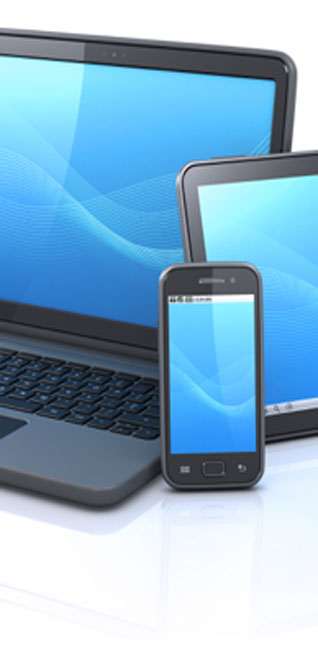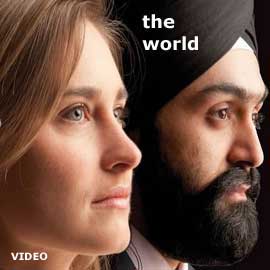Daily Fix
iSikhi
eSikhi
T. SHER SINGH
The digital revolution has turned our lives upside down ... and the world on its head.
In some ways, potentially for the better.
As for its negative impact, though the jury is still out on it, it is futile to fret over it because change as big as this one -- like the industrial revolution -- is here to stay.
Except for those who make a real effort in understanding the brave new world and nevertheless dare to march to the beat of their own drum, the rest of us merely go along with the flow.
Unless, of course, it jolts us awake and stops us in our tracks.
Which is what is happening in terms of the religious practices which we hold so dear.
For example, the role of the Guru Granth Sahib in Sikhdom is unlike that of any other scripture anywhere. It is treated like a living Guru, a royal presence any where and everywhere a copy of the scripture is present … that is, in the gurdwara or in a home.
There is an elaborate protocol that accompanies the regal presence of The Word, as a mark of respect, not an indicia of any form of idol-worship. Our conduct in the Presence is akin to the reverence we traditionally show in our culture to our teachers, mentors and elders.
But, all of our centuries-old practices around the Guru Granth Sahib are being tested by the advances of technology, especially in the last decade or so.
For example, there are apps now available which give us full and free access to the Guru Granth Sahib on any of the multiple phone and computer devices we now carry on our persons or have about us at any time of the day or night. A flick of the button and the Guru Granth Sahib is on our smart phone, our pod, our tablet, our laptop, our desktop … at home, at work, at play, in the car, in the train, on the plane, or even while walking down the street.
How does that change things for us, especially around the protocol we normally follow so lovingly vis-à-vis our Guru?
Has much thought been given to this question? Is any institution studying the issue and its ramifications? Or is each one of left to our individual wisdom to carve out our own way of adjusting to the changes?
Jews too have a close and special relationship to their scripture, though not identical to ours. They also have a very detailed and elaborate protocol around their religious practices … such as, for example, relating to the Sabbath.
Though we as Sikhs are free of the same level of complicated observances, it is still worth looking at how Jews are grappling with the impact of the digital revolution on their religious practices.
It gives us a clue as to how we too should be reviewing our own practices under the new circumstances. We may have it easier in making our adjustments, but the big question for us is: are we thinking about it, or are we merely flying by the seat of our pants?
The following is an excellent piece on how “The digital revolution chips away at an ancient barrier: The Jewish Sabbath”. It is offered here, courtesy of The Washington Post, with the hope that it will trigger a similar process of introspection for us.
Remember - our issues are not the same; the answers and solutions are not the same. But a similar process of introspection may nevertheless prove useful for us.
* * * * *
THE DIGITAL REVOLUTION & THE JEWISH SABBATH
Michelle Boorstein
The first time Sam Simon saw a screen used to project prayers during Sabbath services, “it took my breath away.” And not in the good sense.
“It feels intrusive, disruptive on Shabbat,” the 68-year-old McLean techie said of his experience in a D.C. synagogue, using the Hebrew word for Sabbath.
Only the most traditional interpret Judaism’s prohibition on working, or creating, on the Sabbath as prohibiting the turning on of electricity and electronics, encompassing such activities as flicking a light switch, heating up the oven or driving a car between sundown Friday and sundown Saturday.
But the idea that technology in spirit can present a threat to this sacred commandment has permeated much of American synagogue culture, even for liberal Jews such as Simon. Many still consider the sight on Sabbath of a cellphone, tablet or a flashing screen disturbing when they come to services.
As a result, American synagogues have been cautious on technology. Meanwhile, much of institutional religion, hoping to lure back a wandering America, has been using technology to reach more people, experimenting with things like launching church DJs or holding services via Facebook.
But the digital revolution is now chipping away at a millennia-old barrier: The Jewish Sabbath.
Reform synagogues -- a large, liberal part of Judaism -- are expanding their use of technology on the Sabbath, experimenting carefully with live streaming services and projected images. The Conservative movement, long considered the middle road of institutional U.S. Judaism, had an intense back-and-forth this summer over a proposal to use e-readers to pray on the Sabbath. And while Orthodox Jewish leaders are unanimously opposed to turning any device on during the Sabbath, reports are being widely shared in the past year or so that huge numbers of young Orthodox send text messages, seeing it as socializing, not work.
They call it “half-Shabbos” (Shabbos is the Yiddish word for Sabbath.)
The issue will be highlighted this weekend because of Yom Kippur, the holiest day on the Jewish calendar and one of the few times a year most U.S. Jews go to synagogue. Sabbath rules apply on Yom Kippur, which happens to fall this year on the Sabbath [Friday, September 13 - Saturday, September 14].
Beliefs and practices around technology and the Sabbath differ widely among U.S. Jews.
The Orthodox believe the process of electricity constitutes “creating” something and have systems of timers for things such as stoves and air conditioning, and avoid electronic doors and hotel key cards. Many ultra-Orthodox are opposed to use of the liberal Internet altogether and use “kosher phones” that don’t connect to the Web. Reform rabbis are fine with electricity and many have long used electrified musical instruments and screens to broadcast crowded services into overflow rooms, but have been hesitant on video cameras, e-readers or screens in the sanctuary. Conservative rabbis are somewhere in the middle, and are divided on much of this.
The questions are all new. Jewish law bans writing on the Sabbath, but are pixels -- or the digital record of them -- writing? If you type a search term into an iPad that holds scripture you’re using to pray, did you just write? Does downloading create a record the way writing does, even if you’re downloading some Talmudic analysis? If your community is on Facebook, are you connecting or disconnecting on the Sabbath if you post there?
For some the issue is simple: a desire to unplug. For others the concern is Jewish law, and how to interpret the ancient, detailed 39 categories of forbidden Sabbath work in our new, wired world. For others it’s cultural: Electronics just don’t mesh well at synagogue.
“It just doesn’t feel Shabbasdik,” Ethan Seidel, rabbi of the Conservative Northwest D.C. synagogue Tifereth Israel, said of projectors and screens, using a Yiddish adjective for the special, holy vibe of the Sabbath.
Seidel said screens are “intriguing” (though he doesn’t want to use them), he isn’t totally opposed to e-readers (as long as they’re not the wired ones you could use to surf the Web) and that he has structured some services like plays -- so he’s open to experimenting. But he feels Jews should be wary before messing with the walls that have protected the Sabbath.
“I think there are a lot of people completely taken with technology and have lost their critical faculties,” Seidel said.
Conservative leaders had a dispute this summer when a prominent rabbi suggested using e-readers on the Sabbath during a convention of North American Jewish men’s clubs leaders -- arguing that such devices are becoming the equivalent of books. The proposal was withdrawn.
A year earlier, the leader of the movement’s key rabbinical school wrote an 80-page opinion saying electronic devices violate the Sabbath because they create a record, which is too much like writing. Rabbi Danny Nevins’ opinion was approved by the Conservative Movement’s Committee on Jewish Law and Standards by a vote of 17 to 2.
Proponents of more experimentation counter with the obvious: The vast majority of Jews are already using the whole range of technology on the Sabbath. Judaism can’t be shut out of the digital revolution.
“Judaism is itself a technology. You name it -- Torah study, mitzvot, prayer, all these things are technologies that exist for you to connect more deeply with yourself, your community and God,” said Gil Steinlauf, rabbi of Adas Israel, a large Northwest Conservative synagogue currently reviewing its Sabbath electronics practices, from e-readers to live streaming video.
The cutting edge is at LabShul, a lay-led group that will host 1,000 people at a Tribeca arts center this weekend for Yom Kippur. The entire service will be, as it has been for seven years, projected on large screens. Images will include paintings of God by LabShul children, layered with verses of scripture. Pictures of stained glass windows will flash on the screens.
LabShul is led by Israeli-born actor and rabbinical student Amichai Lau-Lavie, whose uncle was the chief rabbi of Israel and who unplugs from calls and e-mails each Sabbath. He talks and writes about what prayer was like before the creation of books, before people’s hands and eyes were focused on the page.
“We have to be sophisticated consumers of technology, to see what violates our sacred space and time and what doesn’t,” he said this week. “I expect no less of Judaism at thousands of years old to come up with creative solutions, and it’s happening right now; we’re in the middle of it.”
In recent years, there have been groundbreaking digital translations of the Talmud, revolutionizing prayer for Orthodox Jews who need daily access to the Talmud’s 30-plus volumes. Using your device for non-Sabbath daily prayer is fast becoming so standard that sometimes people absentmindedly kiss their iPhones after praying -- a ritual normally done with books.
Some Orthodox rabbis observe the “half-Shabbos” phenomenon and see something hugely important: The forming of a new Orthodox approach to technology. Others see run-of-the-mill rebellion.
Simon is someone who appreciates the importance of the Sabbath. He halts work and e-mail and spends the day at his synagogue, Temple Rodef Shalom in Falls Church. As a more progressive Jew, however, he believes Sabbath is more about your routines than what technology you use. He chuckles a little when recalling his jarring experience a few years ago at another synagogue.
“I’m a bit of a reluctant traveler, but I’m warming” to technology, he said.
Which is good, since Rodef Shalom leaders say they plan to experiment more with screens.
[The Jewish Sabbath article, courtesy: The Washington Post.]
September 14, 2013
Conversation about this article
1: Manpreet Singh (Atlanta, Georgia, USA), September 14, 2013, 3:37 PM.
Great article to remind and encourage us to find alignment between Rehat Maryada and the digitization of scriptures, amongst other innovations, that are being enabled by technology. The immediate dilemma that has been dawning on me is, should we try and find ways to take Hukam from the digital version of Guru Granth Sahib.
2: Gobinder Singh (USA), September 15, 2013, 6:18 PM.
Technology for Sikhs is always welcome! I think Sikh institutions have been very accepting of the change and it will help us in the long run. Projector screens with English translations while raagis are singing shabads, numerous online versions and translations of Guru Granth Sahib, mp3s of shabads from various raagis, you name it ... we already have it! As for following elaborate protocols, that's just transitory change. I welcome the focus away from the treatment of Shabad Guru as an idol which is taking place in various deras and small communities. I have seen people focusing on things like air conditioning, kind of perfumes to use, how expensive rumalas should be for Guru Granth Sahib and yet never read a single page in their whole life. The elaborate protocols have only restricted access to Guru Granth Sahib and its message for the common man. The granthis and jatehdars want to keep it that way because it helps in keeping them in their positions. That's not Sikhi.
3: Sangat Singh (Kuala Lumpur, Malaysia ), September 15, 2013, 8:07 PM.
The initial reaction always is that it is against Maryada -- a panacea, an all purpose cure for everything. In 1913 when Amritsar was first electrified and soon after Harmandar Sahib came in its ambit, there was the usual hue and cry that it was against maryada to replace ghee burning lamps. Recently, there was a reaction against air-conditioning of the inner sanctum. Now, the digital revolution portends to turn life upside down in the name of sanctity. We are still grappling with the question of chairs and tables for langar. The digital revolution has now made life easier. Any shabad can be found in a jiffy and painlessly. Prior to that the only ground breaking was done by Akali Kaur Singh who spent a lifetime to produce a monumental, first ever comprehensive index that could trace any shabad. It was known as "Gur Shabad Ratan Prakash". It was reprinted by Bhasha Vibhag, Patiala, Punjab in 1963. I am still holding onto that precious much over-worked volume that has served me extremely well. It has now earned a much needed rest and retirement thanks to the digital revolution. "Sikhee sikhi-aa gur veechar" [GGS:465.10] -- "Contemplating the Guru, I have been taught the Message."
4: H. Kaur (Canada), September 16, 2013, 4:43 AM.
My brother and his wife would never have dreamed of taking a gutka on the bus, but had no problem doing Sukhmani Sahib using an ipod on their long commutes to and from school.
5: Bhupinder Singh Ghai (New Delhi, India), September 16, 2013, 7:05 AM.
Of course the digital version of our scripture are here to stay. I have been traveling for the last four weeks to different parts of the world, including a seven-day cruise on the Mediterranean Sea. I cannot express the joy and ecstasy I felt reading from the Guru Granth Sahib (digital version) every day. Having said that, I still have doubts over certain protocols with regards to reading Japji Sahib or other banis while bathing. I know many people who do it, but somehow I haven't really found a convincing answer yet. Maybe the learned sangat can guide us better.
6: Baldev Singh (Bradford, United Kingdom), September 16, 2013, 9:42 AM.
We readily welcome and embrace all technology that gives us easier and better access to gurbani.
7: Ravinder Kalra (Brampton, Ontario, Canada), September 22, 2013, 11:31 PM.
I guess we can maintain a parallel system where we must continue to offer utmost respect to the saroop of Guru Granth Sahib open or closed, i.e., chetan or moorat. As a moorat, it still acts as the model of Akal Purakh and it reminds us of him. Our prayers are always answered. On the other hand, I can't even dream of giving up the flexibility that digitization of gurbani has given us. It has executed the concept of "Guru merey sang sada hai naaley". I have also become dependent on the live kirtan from Darbar Sahib and really miss it on the days when there is any interruption. No superstitions here that gurbani should not be playing while we are running around doing our chores. In fact there have been full nights when my Blackberry Playbook has been "on" streaming the live kirtan which is the ultimate "lori". To answer S. Bhupinder Singh ji's comment, my take is simple, if we long for 'swas swas simran', we can't escape remembering him any time anywhere, washroom and ablutions included.




